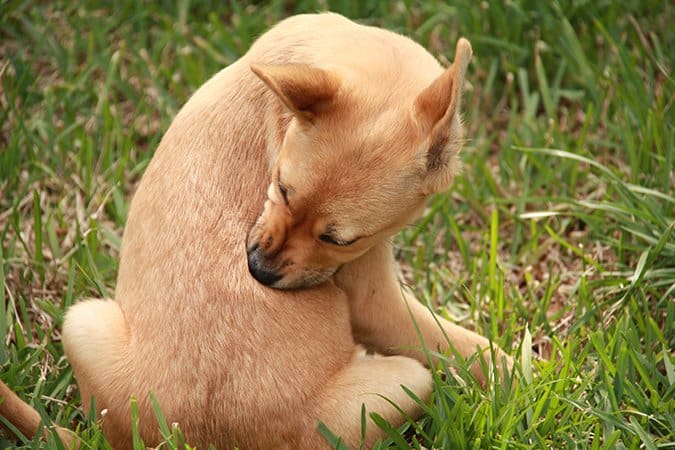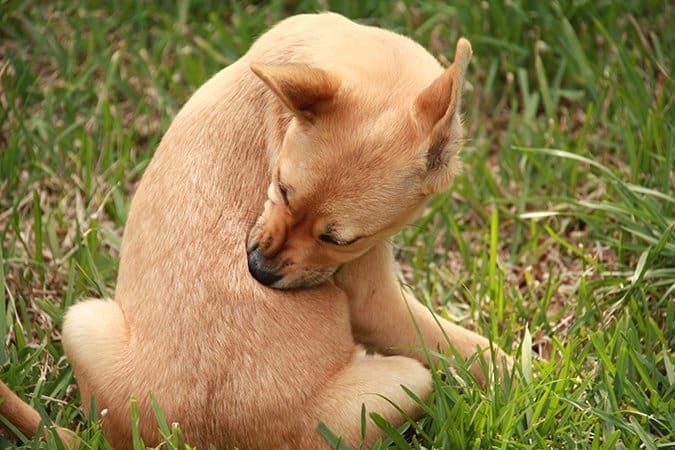Download the Full April 2015 Issue PDF
Proud of my Grand-Dog (and his owner)
Last weekend, I was in the San Francisco Bay Area for a quick overnight trip, taking care of some family business. I didn’t have time on this trip to hang out with my son; we were both very busy and so we only had time to have breakfast together. He suggested we meet at a breakfast spot that has tables outdoors; it was a lovely morning and he wanted to bring his dog, Cole, as he wasn’t going to have much time to spend with Cole later in the day.
I got to the restaurant first and selected a table that is in the middle of the sunny sidewalk in front of the restaurant. A few minutes later, my son parked across the street. I watched him and his dog stroll calmly across the street, but I didn’t call out to either of them; I wanted to see how long it would take Cole to recognize me. I was the one who pulled him out of my local shelter a year and a half ago, and he’s spent lots of time at my house when my son has been traveling with his sports team.
It was clear that Cole registered only the sight of “people” sitting at the table that my son was leading him toward, and his tail wagged in a friendly, relaxed way as they approached. I sat perfectly still and quiet. He casually sniffed in the direction of my shoe as my son stopped by the table and suddenly, his head came up and his entire demeanor changed. “Oh, it’s you!!” His whole body wagged and he whined and tried to lick my face as I rubbed his shiny shoulders and caressed his silky long hound ears. My son complained, joking, “He was good until he saw you!”
The cool thing was, once past his surprised and enthusiastic greeting, he was good, the entire meal. He lay quietly on the sidewalk behind my son’s chair, and never once begged for food or attention. Several times, people walked by our table, twice leading dogs of their own, and each time, Cole watched them go by but never acted as if he might get up. Instead, he glanced at my son, and seeing no sign that he might be invited to greet the other dog, he looked away from the other dog, indicating clearly that he wasn’t going to interact. My son takes Cole to work with him a few days a week, and it’s obvious they have been practicing this behavior, which is vital for an “office dog” to know. My son occasionally reached down to rub the top of Cole’s head, and even gave Cole a bit of ham a time or two, reinforcing Cole’s calm, composed “down-stay.” He’s just done a bang-up job with this dog, his first “own” dog, and I could not be prouder of both of them.
(Kennel Cough #1) Kennel Cough and Colds
The two most common afflictions of the respiratory system are the “common cold” and kennel cough. Both of these ailments are usually instigated by any of a number of viruses, often followed by secondary bacterial invasion. The severity of the symptoms varies widely, but in most “colds” they are mild and include wheezing, coughing, reluctance to move, and perhaps a mild fever.
Kennel cough (a.k.a. infectious tracheobronchitis), on the other hand, can produce symptoms that appear extreme, with a dry, hacking cough accompanied by frequent, intense gagging. I’ve had caretakers rush their kennel-coughing dog in to see me, thinking he has a bone caught in his throat. Despite its appearance, a typical case of kennel cough is not life-threatening, and it tends to run its course in a few days to a week or so. But it is a disease that is frustrating for pet and caretaker alike.
Kennel cough results from inflammation of the upper airways. The instigating pathogen may be any number of irritants, viruses, or other microorganisms, or the bacteria Bordetella bronchiseptica may act as a primary pathogen. The prominent clinical sign is paroxysms of a harsh, dry cough, which may be followed by retching and gagging. The cough is easily induced by gentle pressure applied to the larynx or trachea.
Kennel cough should be expected whenever the characteristic cough suddenly develops 5 to 10 days after exposure to other dogs – especially to dogs from a kennel (especially a shelter) environment. Usually the symptoms diminish during the first five days, but the disease may persist for up to 10-20 days. Kennel cough is almost always more annoying (to dog and her caretaker) than it is a serious event.
For advice on preventing kennel cough as well as natural and effective ways to soothe the symptoms, purchase Kennel Cough Prevention and Remedies from Whole Dog Journal.
(Kennel Cough #2) Bordetella Vaccination
Most boarding facilities require proof of Bordetella vaccination for dogs who will be visiting. However, because there are many strains of Bordetella, and because no vaccine protects every patient, some immunized dogs contract tracheobronchitis despite being vaccinated. Veterinary recommendations range from vaccinating every four months to not at all.
“There are two kinds of Bordetella vaccine,” says Stacey Hershman, DVM, a holistic veterinarian in Hastings-on-Hudson, New York. “The intranasal vaccine is highly effective and very safe since it is not systemic but goes down the nose into the throat. I do not recommend the injectable vaccine since it can cause negative side effects like lethargy, fever, vomiting, or diarrhea.
“I never vaccinate animals more than once a year for kennel cough, and then only if they are going to a boarding kennel. Kennel cough is not fatal in adult dogs, who usually board, therefore it would be over-vaccinating in my opinion to do it more than once a year. Healthy, strong immune systems are resistant and do not catch it, which is another reason not to vaccinate unless the dog is going to a kennel that requires it.”
No matter what your dog’s vaccination status, a few natural preventives can’t hurt, especially whenever your dog is exposed to dogs with active or recent infections.
For advice on preventing kennel cough as well as natural and effective ways to soothe the symptoms, purchase Kennel Cough Prevention and Remedies from Whole Dog Journal.
(Kennel Cough #3) Clearing the Air
When Faith Thanas, an aromatherapist who lives in Leicester, Massachusetts, adopted a Doberman Pinscher from Louisiana one year after Hurricane Katrina, Sasha arrived in a van carrying 20 rescued dogs. A few days later, she started coughing.
To help soothe Sasha’s throat, Thanas mixed a blend of essential oils to spray in the air around the dog. She started with Ravensare (Cinnamonum camphora), one of the “must have” essential oils listed by Kristen Leigh Bell in her book Holistic Aromatherapy for Animals. As Bell explains, this gentle and tolerable antiviral, antibacterial essential oil supports the immune system and has tonifying effects.
Thanas then added Eucalyptus radiata, the gentlest of the many eucalyptus varieties available. It is known for its antiviral, anti-inflammatory, and expectorant properties. Bell writes, “Due to its gentleness, it is very appropriate for use in blends for animals for congestion, and it makes an excellent room air cleaner, deodorizer, and flea repellent.”
Eucalyptus globulus, the next ingredient, is the eucalyptus commonly found in chest rubs, cough drops, and cough syrups. It has a fresh antiseptic fragrance and, when inhaled, acts as a decongestant.
Thanas added Spike Lavender (Lavendula latifolia) for its powerful antibacterial properties.
After diluting the essential oils, Thanas used a spray bottle to mist the air around Sasha. “The results were instantaneous,” she recalls. “She stopped coughing, she was able to breathe, and she was so much more comfortable.”
For advice on preventing kennel cough as well as natural and effective ways to soothe the symptoms, purchase Kennel Cough Prevention and Remedies from Whole Dog Journal.
(Vaccinations #1) Vaccine Titer Tests
The use of vaccine titer tests can help you decide whether or not your puppy is completely protected from disease after her “puppy shots,” or if your adult dog really needs any more core vaccines.
It’s a similar situation with annual or semi-annual so-called vaccine “boosters” – not many people know much about their dogs’ vaccination status, so they take their veterinarians’ word that their dogs are “due” for more vaccinations.
The truth is, there is no single vaccination protocol that will protect all dogs for all things, without over-vaccinating most of them. Vaccination really ought to be determined on a case-by-case basis, because each dog’s risk factors are unique, based on his age, genetic inheritance, current health, geographic location, and lifestyle.
That said, there is a very useful tool that can help an owner gain solid information about whether her dog is likely to be protected against the most common infectious diseases: the vaccine titer test. Positive test results can also give a dog owner some solid ammunition for countering those who blindly promote (or require, in the case of some boarding or training facilities) so-called “current” vaccinations, which can mean many different things to different people.
To read more about vaccinations, purchase the Whole Dog Journal ebook, Vaccinations.
(Vaccinations #2) What are Core Vaccines?
Core vaccines include:
- Canine distemper virus (CDV, commonly referred to as distemper)
- Canine parvovirus (CPV, parvo)
- Canine adenovirus (CAV, better known as canine hepatitis)
- Rabies
Among healthy dogs, the first three “core” vaccines are expected to induce a protective immune response lasting at least five years. However, much longer protection from these vaccines has been demonstrated in dogs in many studies – some- times, even as long as the dogs’ lifetime.
Rabies is a slightly different case. Because the disease poses a significant risk to human beings, it’s the only vaccine that is required by law to be administered to dogs. Each state has its own legal requirements for rabies vaccination. Some require annual rabies vaccinations; the rest require the vaccination be given every two or three years (depending on the state). There is ample evidence that rabies vaccines confer protection from rabies for longer than three years, but given the public health risk to humans, there is considerable push-back from public health officials to the idea of ex- tending the legal requirement for rabies vaccines.
To read more about vaccinations, purchase the Whole Dog Journal ebook, Vaccinations.
(Vaccinations #3) How Antibody Titer Tests may Affect? your Decisions?
Antigens are any substance that the immune system identifies as an invader and responds to by producing a chemical defense: antibodies. When everything is working as it should, your dog’s immune system will recognize disease antigens that were introduced to his system via a vaccine (weakened or killed) or by natural exposure to the antigen that causes the disease (viral or bacterial).
A “titer” is a measurement of how much antibody to a certain antigen is circulating in the blood at that moment. The result is usually expressed in a ratio. A positive titer test result is strongly correlated with a good antibody response to either a recent infection or vaccination. A dog who has received “core” vaccines and who displays a positive antibody titer test result should be considered protected from the diseases for which he was vaccinated (meaning, he doesn’t need vaccines at that time).
Your dog must undergo a blood draw in order to have an antibody titer test. Labs such as Antech, IDEXX, and most veterinary college laboratories offer these tests. Antibody titer testing is typically run for parvovirus and distemper, since the dog’s antibody response to these two antigens is highly predictive as to the dog’s immunologic competence in dealing with any other antigen to which he has been exposed.
To read more about vaccinations, purchase the Whole Dog Journal ebook, Vaccinations.
Advice for a First-Time Dog Owner
My son was lucky enough to land his first job out of college working for a company that allows employees to bring their dogs to work. The company has about 140 employees, and my son tells me that on any given day, about a dozen or so dogs can be found around the office.
He brings his dog to work one or two days a week. Cole, an American Black and Tan Coonhound-mix, is very well behaved, but he’s also about 1½ years old - an adolescent – and not ready for “office work” all day, every day. On the days he’s planning on bringing Cole to work, my son gets up early and takes Cole for an extra-long run before work, to help ensure that Cole is relaxed and calm all day, not looking for other dogs (and people!) to play with, or whining with boredom.
I am proud to say that my son reports that he has been told a number of times that his is the best-behaved dog at the office, and that several co-workers have asked for his dog-related advice. One such co-worker went so far as to ask my son for advice on choosing his first-ever dog! While my son is a gifted dog handler – having had to handle dogs for modeling for WDJ since he was five! – he felt a little over his head with this request. So he asked me to help his friend 😉
Via email, I asked his friend/co-worker what he was looking for in a dog; his first response was that he wanted a really friendly dog who enjoys being petted. He’d prefer a dog with a short coat, medium-sized . . . but these were not deal-breakers in the right dog, and he had no breed or sex biases. He did emphasize that he’s never had his own dog before – so what that tells me is that he needs an easy dog, preferably an adult, with either some training or highly trainable, and very well-socialized. He is hoping to be able to bring his dog to work, too, so the dog must be really good with other dogs.
I think I found a good candidate for him at my local shelter; I took some pictures and video of the dog and sent them to him, and he’s interested. We’re planning for them to meet this weekend. I’ll keep you posted on how it goes.
In the meantime, he asked me one more question via email: “Do you have any suggested readings on preparing for a dog?” And I thought I would put that question to you! If a person had time to read ONE book before bringing their first-ever dog home, what book would you recommend?
And, to take things one step further, if you had ONE piece of advice to share with a first-time dog owner, what would it be?
Who’s Smarter?
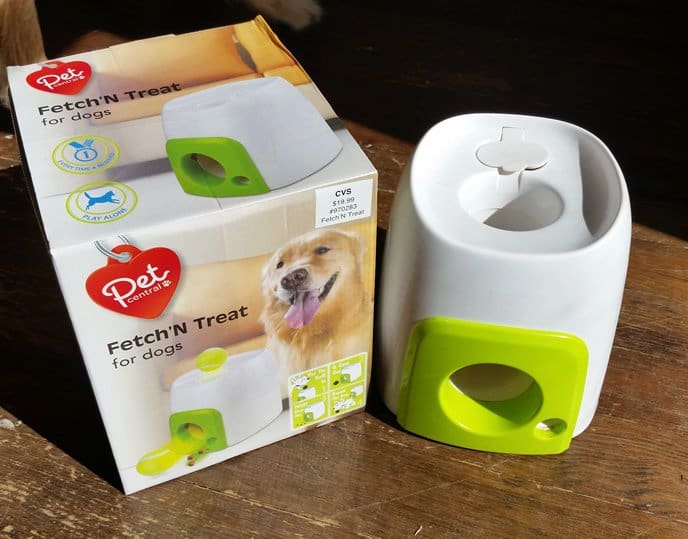
One of my friends has a dog, Lena, who recently tore her ACL. She’s on as much crate rest as my friend can manage. Ordinarily, Lena is a highly active dog, and keeping her quiet while her knee heals is quite a chore. Lena had surgery on her OTHER knee a few years ago, and my friend has been told that Lena’s hips are highly dysplastic, so my friend has invested a lot in finding ways to keep Lean busy while keeping her inactive. She owns lots of food-puzzles and tons of toys and Lena eats only out of Kong toys…anything to keep her occupied and prevent her from tearing the house apart.
One day my friend came home from a shopping trip, happy about a toy she found in a chain drug store (CVS) called the Fetch N Treat. It’s a low-tech toy that dispenses treats when a ball is dropped into the top. When the ball is dropped into a hole at the top, it presses a lever that makes treats sprinkle out, and the ball itself also rolls out of the toy. My friend said that she loaded the toy with a combination of kibble and treats, and showed the ball (tennis ball-sized but heavier) to Lena, demonstrated dropping the ball into the hole at the top of the toy to Lena two times, allowing Lena to first eat the treats that were dispensed and then pick up the ball. And then Lena herself dropped the ball into the top of the toy, ate the resulting treats, fetched the ball, and did it again.
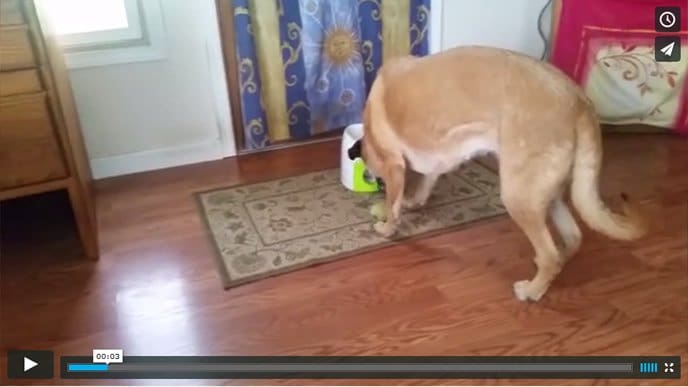
I was both impressed and a little dubious. I’ve never thought Lena was all that smart, frankly. My friend got her when she was about three or four months old, and she’s always been kind of a hardhead and slow to learn or at least, slow to learn good manners behaviors. She’s never been all that reliable with recalls or paying attention to her owner on the trail. So I had to see this for myself. I ended up driving over to my friend’s house that day to see both the toy and whether Lena could, as advertised, operate it that quickly and efficiently.
It turned out that yes, she could. My friend set it up and she went to work like a factory worker. Get the ball, drop it in, eat the treats, get the ball, drop it in, eat the treats…Score one for Lena, Nancy zero.
So what’s next? I had to drive right over to CVS and get one of the toys myself so I could see what my dogs would make of it.
Tito the Chihuahua was alternately interested in the ball and the treats. No matter how many times I demonstrated, he would either chase the ball and leave, or eat the treats and then look for more. It seemed like he couldn’t comprehend the connection between the two. But I didn’t think he would. I had higher hopes for Otto. He’s far more interested in training and learns new tasks really quickly. I’ve played shaping games with him many times, like 101 things to do with a box, and he’s always been quick to understand when I want him to find a new behavior; he’ll persist in trying behavior after behavior until he finds something that earns him a treat.
I demonstrated the toy for Otto. He, too, failed to see the connection, or at least, failed to show that he cared enough to operate it himself. He did seem to quickly grasp that treats would come out of the toy if I put the ball into the hole at the top, but he also figured out that if he nosed the toy super hard and made it fall over, the treats would spill out then, too.
I was able to coach him into bringing the ball toward the toy, and even managed to direct him into dropping it into the top of the toy, but I could see that there was no way he would have managed to do it without heavy coaching. Left to his own devices, he just started pawing and nosing the toy (hes played with a lot of food-dispensing toys that require manipulation to dispense the treats).
Today, I drove back over to get some video of Lena operating her toy. Shes had it for about two months and her owner sets it up for her to play with a few times a week. She is an absolute expert at it now. She doesn’t get frustrated, but just tries again, if she puts the ball in and it fails to dispense a treat (sometimes they get stuck). Sometimes the ball gets stuck inside, and shes learned to nudge the toy hard if this happens, to get the ball to roll out. She doesn’t need any encouragement or direction; she clearly understands exactly how the thing works.
So much for my understanding of canine intelligence.

Really? A Dog Park I’d Visit?

I just found the ideal dog park. It’s in Grass Valley, California, in a gorgeous public park called Condon Park.
It’s large, and set in a forested setting, with tall pines overhead, and the footing is thick with pine needles.
It has two separate areas, with a smaller section (but still quite good-sized) reserved for “small and shy” dogs. I love that the folks who set it up did not specify small dogs only. What do you do when you have a dog who needs to really run and romp and get tired, but isn’t reliable off-leash yet . . . who could benefit from some socializing, but isn’t yet ready to be accosted by large, high-energy buddies?

There are multiple entrances, each with a double-gated “airlock.” But the park planners have improved on the norm by including signs that encourage people to use one of the other entrances if there is a crowd by the first one they approach. And there is also signage that instructs people to remove their dogs’ leashes in the airlock area before turning them loose in the large area (which prevents owners from getting caught in the middle of a rambunctious group of dogs who are trying to greet the incoming dog, and prevents the dog whose leash is not yet released from being hindered from running or defending himself from the onslaught of even fun-loving, well-meaning playmates).

The entrance of each area includes a paved sidewalk that extends well into each of the two play areas – something that was being taken advantage of by a guy I saw who was there in a wheelchair with a big Lab-mix. In my home-town dog park, at this time of year, and there is no paved path into the play area at all; the entrance is quite muddy. The sidewalk, by the way, extends all the way in both play areas to a concrete patio-type area where fresh water is provided; there are several big bowls and a faucet with a hose to fill them with. The water was cleaner (and the dogs were cleaner) than in the parks I’ve seen where the water is provided in a gravel (or dirt/mud) area.

There are multiple benches for people to sit on, and organizers had sought out donations to help support their installation and maintenance; signage on the benches thanks the donors and advertised their services where appropriate. There are also agility-type obstacles scattered about for people to explore with their dogs - fun! I counted at least six dispensers for poop-pick-up bags, and as many barrels for disposing poop. There were also several poop pickup tools in various spots.
At the main entrance, there is a bulletin board with an area where anyone can post signs about lost dogs or dog-related services, and a locked area under glass where the organizers can post official notices that couldn’t be ripped down or altered. A large sign with clear, firm, and reasonable park rules appears there. There is more signage acknowledging the major community sponsors of the park.
When I first approached the park with Otto, I thought at first no one was present, because it was so quiet, and because the park is so large that I didn’t see several groups of dogs playing at the far end of the park. When we entered, there wasn’t an immediate rush of over-amped, anxious dogs racing over to rudely greet Otto; the dogs there were playing energetically, but when they approached, it was with casual interest, not with the kind of drive that makes you think of a mob with pitchforks and torches. It was clear to me that the pack’s mood was a result of the relaxed, calm atmosphere.

I don’t take dogs, any dogs, to the dog park in my town. It’s just not a pleasant place to take a dog. And in my former home town, there is a lovely park, but it’s so overrun, and so heavily populated by dogs who seem to LIVE there (they are there for so many hours a day, and so many days of the week), that they are quite belligerent and territorial. I’ve seen and photographed many dog fights (and human fights!) there that were caused by too much out-of-control, hyper energy – too few rules with zero community enforcement, and too many bullies (canine and human). It’s the kind of place where the loudest voices bully owners into making bad decisions for their dogs, for example, as the scared adolescent dog is running in a blind panic, being chased by three or four larger, intense dogs, the kind of person who says, “Don’t be overprotective, dogs have to work it out! Your dog needs to learn to defend himself!” Blech.
But this park? I would bring any nice dog there, anytime. Kudos, Grass Valley.

Suspect Your Itchy Dog Has a Food Allergy?
If you suspect your dog has a food allergy, follow these steps:
1. See your veterinarian to rule out other possible causes.
© Luckybusiness | Dreamstime.com
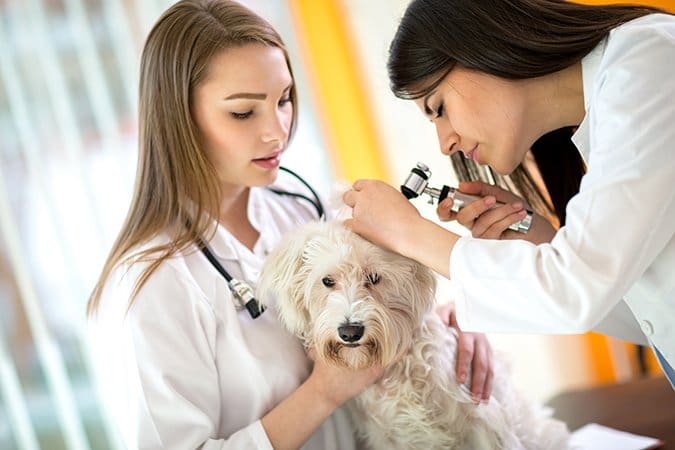
2. Save your money if someone recommends allergy tests. They’re unreliable.
3. Ask your veterinarian to help you construct an elimination diet.
4. Choose a carbohydrate source and a protein source that you are comfortable feeding, that your dog will readily and comfortably consume, and that you can afford for weeks at a time. (For instance, fresh ground buffalo may be available from your local Whole Foods, but feeding that as the daily protein source for your 80-pound Labrador may not fit into your budget.)
5. Check all your dog’s medicines for flavorings and get substitutes, if necessary.
6. Stop all supplements during the trial.
7. Take photos of all chewed, bare, or irritated spots on your dog’s body at the start of the trial, so you have something to compare with as the trial goes on.
© Ladykassie | Dreamstime.com
